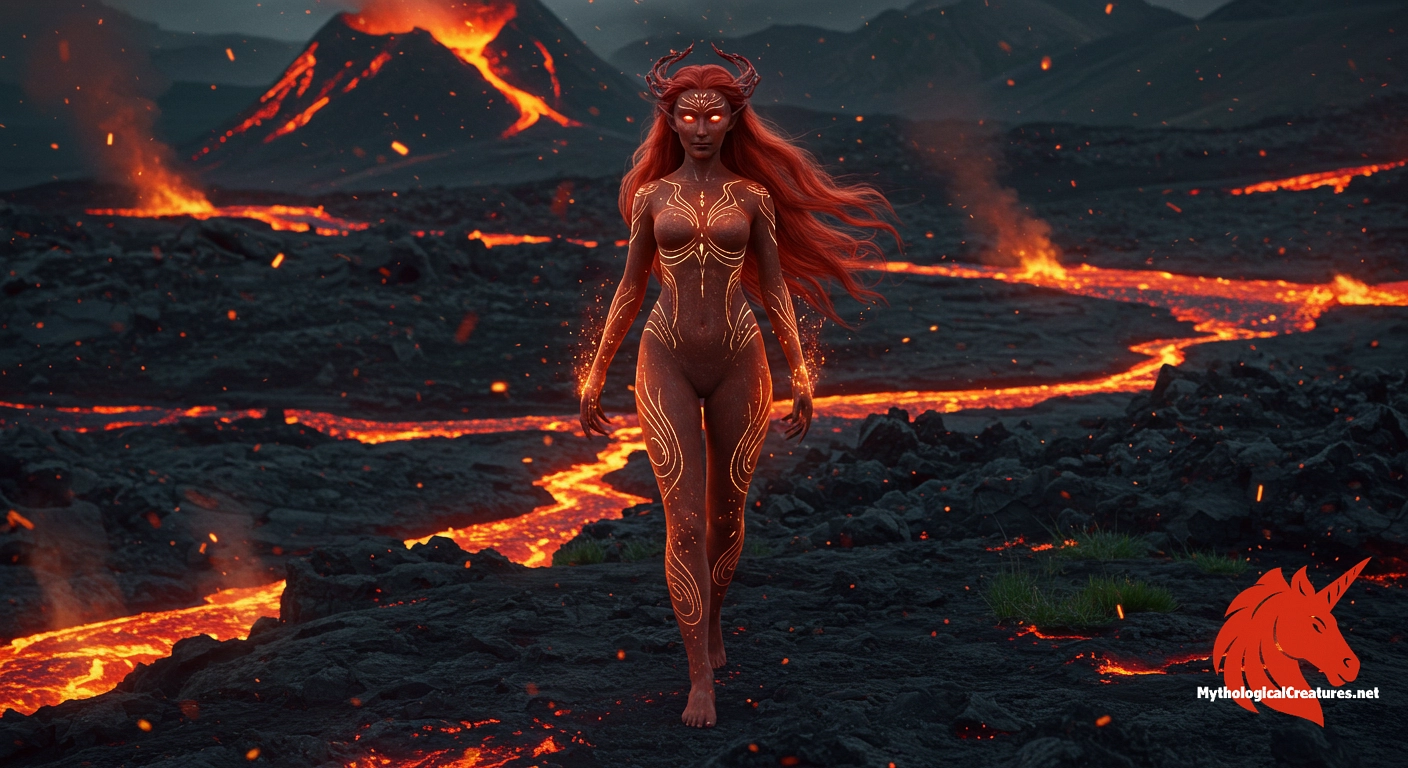Glöð: Glöð is a legendary queen in Norse mythology renowned for her association with glowing embers and elemental fire.

Glöð
Glöð - Glöð embodies the elemental force of fire and represents the fusion of jötunn and elf lineages in Norse mythology, reflecting the complex dynamics of divine and natural forces.
Origins & First Encounters
Glöð is a legendary queen whose story radiates with the luminosity of glowing embers and is deeply entwined with the tapestry of Norse myth. Born amidst the interplay of magical realms, she emerges in the saga of Þorsteins saga Víkingssonar as a figure both majestic and enigmatic. Her parentage is as remarkable as her name; she is the daughter of Grímr of Grímsgarðr from the formidable realm of Jötunheimr and Alvör from the ethereal lands of Alfheim, symbolising a synthesis of contrasting cosmic energies. This unique lineage imbues her with qualities that traverse the boundaries between giants and light elves, underscoring the fluidity of mythological heritage. Married to Logi, the embodiment of fire and a fire giant in his own right, Glöð’s narrative reverberates with the primal pulse of flame and transformation. Over time, her story has been celebrated for bridging the ephemeral world of gods with the tangible forces of nature. The vibrant imagery surrounding her has resonated with audiences for centuries, intertwining elements of beauty, power, and elemental mystique. In the cultural milieu of the Norse, her tale serves as a reminder of the dynamic forces that shape both the cosmos and human imagination. As a mythological figure rather than a historical persona, her existence has come to encapsulate the transcendent aspects of Norse lore. Her enduring appeal continues to inspire reinterpretations that blend ancient symbolism with modern sensibilities.
Source Texts & Tale Variants
Glöð’s myth is primarily preserved in the narrative of Þorsteins saga Víkingssonar, which serves as a key source outlining her origins and relationships within the mythic hierarchy. This saga provides a succinct yet evocative account of her heritage, detailing her connection to both the giants and the light elves. The textual tradition places her within a rich framework of Norse legends that value hybrid identities and elemental power. Although the surviving literature on her is not extensive, multiple versions have emerged through oral and written traditions that embellish her character. Variations in her portrayal are evident in differing manuscript traditions, where some threads even suggest a divine quality in her persona. The influence of other texts, such as the references to her consort Logi in the Prose Edda, helps to situate her within a broader cosmological context. Later storytellers and folklorists have also contributed to her myth, leading to subtle modifications and reinterpretations over time. The multiplicity of sources highlights the adaptive nature of myth, as aspects of her character have shifted to suit regional and temporal needs. These interwoven narratives serve to enhance the mystique that surrounds her, making each version a unique fragment of a larger mythological mosaic. The evolving corpus of texts not only underscores her importance in Norse tradition but also invites continual reexamination of her story.
Form & Powers
Even though detailed physical descriptions of Glöð are sparse in the ancient texts, her imagery is rich with symbolic resonances that evoke the essence of fire and light. She is often envisaged as possessing an ethereal beauty that mirrors the luminous quality of glowing embers. Artists and storytellers have imagined her with flowing, fiery hair and eyes that seem to spark like the glint of a hidden flame, suggesting a form that is both delicate and commanding. Her presence is frequently described in terms that blend regality with an almost supernatural energy, capturing the paradox of fire’s warmth and its potential for fierce destruction. The interplay of light and shadow in her depictions symbolically reflects the contrasts inherent in her divine ancestry. Although the surviving accounts do not detail her exact measurements or attire, imaginative re-enactments propose garments rich in vivid hues, interlaced with designs reminiscent of dancing flames. This fusion of physical grace with elemental symbolism grants her an iconic status that transcends mere human beauty. The subtle details that emerge from her portrayal serve to enhance her aura of mysticism and otherworldly charm. Through such artistic and literary elaboration, Glöð is portrayed as a living embodiment of the dynamic forces that govern natural and supernatural realms. Her image continues to evolve, inspiring modern reinterpretations that emphasise both her physical allure and her elemental power.
Regional Faces
Across the Nordic regions, Glöð’s myth has been adapted to reflect local cultural nuances and environmental landscapes. In Iceland, for instance, her tale is woven into the rugged and dramatic scenery, which lends her an air of stoic nobility and mysticism. Scandinavian interpretations often stress her dual heritage, portraying her as a woman who bridges the ferocity of the giants with the luminous qualities of the divine elves. In Norway and Sweden, her narrative is sometimes re-energised with local heroic legends and folklore, emphasising her role as a formidable sovereign. Some regional accounts have reimagined her as both a guardian of sacred flame and a mediator between the mortal and divine realms. This geographical multiplicity is evident in the way her story is interlaced with local myths, each imbuing her character with traits that resonate with community values. Varied oral traditions have further enriched her legend, allowing for flexible adaptations of her story to suit local mythic registers. Each regional variant, while retaining the core elements of her ancestry and connection to fire, reflects different aspects of the broader Norse spirituality. Such diversity not only illustrates the adaptive quality of myth but also validates the collective cultural ownership of her legend. The regional retellings ensure that her myth remains both timeless and responsive to the lived experiences of different communities.
Cultural Parallels
Glöð occupies a fascinating space in the comparative study of myth, embodying themes common to fire deities and mythic queens from various cultures. Her association with the fierce yet transformative power of flame draws parallels with figures in Celtic mythology, where fire often symbolises both creation and destruction. Much like the embodiment of hearth and flame in other traditions, her narrative resonates with archetypes that merge mortal beauty with elemental might. This duality is reminiscent of mythic characters from diverse cultures who balance the roles of nurturer and destroyer. The synthesis of disparate ancestries in her origin story finds echoes in global myths where divine unions produce extraordinary beings. Her evolving spiritual stature can also be compared to symbolic figures such as the Phoenix, representing cyclical renewal through the force of fire. In many traditions, fire is seen as a purifying and invigorating element, and Glöð’s connection to Logi further cements this theme. The recurring motif of melding opposites—be it light and dark, order and chaos, or life and destruction—appears across cultural narratives, reinforcing her universal appeal. By examining her myth alongside similar figures from Greek, Celtic, and other Indo-European mythologies, one can appreciate how different cultures harness elemental forces to express complex philosophical ideas. In doing so, Glöð’s tale becomes a testament to the interconnectedness of myth across time and space.
Legacy & Modern Evolution
Over the centuries, Glöð’s myth has undergone a significant transformation as it shifted from the pages of ancient sagas into the broader realm of modern cultural expression. Her image, initially emerging from fragmented texts, has been reinterpreted as a symbol of elemental power and transcendent femininity. Modern reinterpretations often celebrate her as an icon of resilience and inner strength, resonating with contemporary themes of empowerment and transformation. Artistic endeavours ranging from literature and visual arts to digital media have revitalised her myth, infusing it with fresh perspectives while honouring its ancient origins. Her earlier misidentifications—such as the occasional conflation with the trickster god Loki—have been re-evaluated, allowing scholars and enthusiasts to recognise her distinct narrative. Contemporary fans of Norse mythology now see her as a multifaceted figure whose legacy spans both spiritual mystery and tangible cultural impact. The evolution of her portrayal reflects broader societal changes in how myth and heritage are understood and valued. Her legacy has also been embraced within neopagan and reconstructionist circles, where she is celebrated as a powerful embodiment of nature’s dynamic energies. Through various cultural lenses, Glöð remains a poignant reminder of myth’s capacity to evolve and inspire. In this way, her enduring myth enriches today’s global narrative, bridging ancient tradition with modern imagination.
Interesting Fact
A common misconception is that Glöð is Loki's wife, when in fact her consort is Logi, underscoring the importance of accurate lineage in Norse myth.
Quick Creature Info
Origin:
Associations:
Our Mythic Legendary Rating:

Also Sometimes Known As:
Habitat:
Supernatural Powers:
Physical Attributes:
Abilities:
Lore:
Related Creatures, Tales or Lore
- PPele
- BBrigid
- HHestia
References
Discover Another Mythical Legend You May Not Have Heard Of?
Uncover the mysteries of ancient folklore and expand your knowledge of legendary beings from cultures around the world.
Dare to Meet the Arsan Duolai....
Curated by the Mythological Creatures Team (rev. May 2025)
